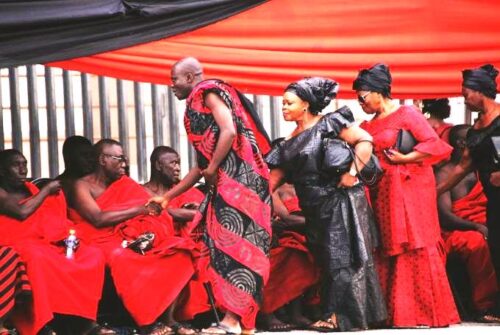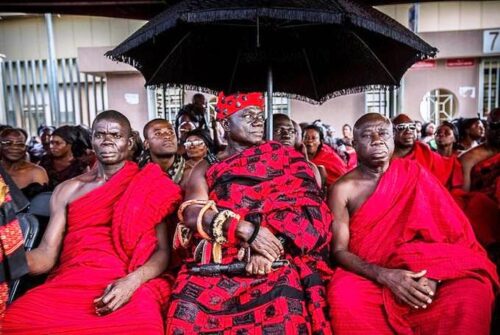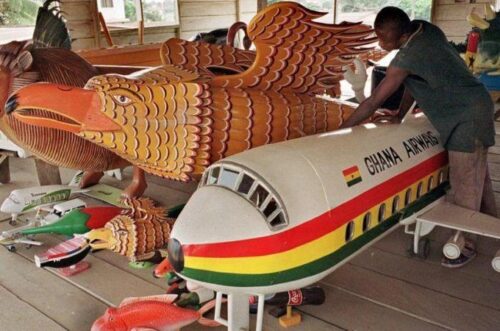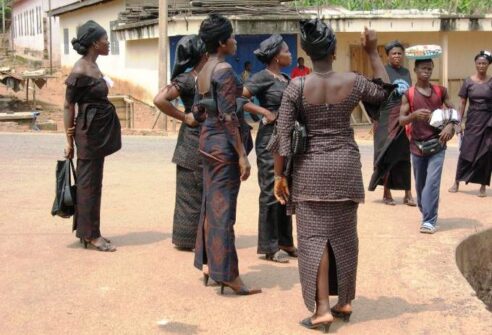The Last Rites.
The Asantes perform rituals for their dead kinsmen and loved ones generally known as ayie (funeral) in the Akan language. They hold a general belief that death is but a transition into a next world termed locally as Asamando (Asante/Akuapim) or Samanadze (Fanti) and not necessarily the end of mankind.
The traditional Asante funeral is a festive celebration in which the whole community participates (not only family and friends of the deceased), where the predominant colours of mourning are red and black and are often climaxed with dances.
The universality of death is expressed in metaphorical Akan maxims – owu adar nndow baako, meaning ‘death’s cutlass does not weed only one individual’. The same idea is conveyed in the symbol of the universal ladder which every person is believed to climb – owu atwer baako mmfow meaning, ‘death’s ladder is not climbed by only one individual’.

When a funeral is well organized and attended to, the whole family gets recognized.
It is normally said that baabi a obi awuo, obi nna (‘no one sleeps where there is death’). In the Akan scheme of things, it is only the body which dies after death; the soul continues to live, and it is sometimes brought back into the world through the concept of reincarnation.
The Asantes recognise two types of death, owu pa (good death) and owu bɔne (bad death). An individual who dies of a natural cause – principally caused by illness – is considered to have died a good death. People who die owu pa can also be associated with those who attain 70 years or more before dying. Some scholars associate good death with dying peacefully. In principle, the Asantes regard good death as dying peacefully, and most importantly not dying from any form of bonsam yarie (evil sickness).When a funeral is well organised and attended to, the whole family gets recognised. They are therefore noted for their strict compliance and cooperation during funerals which are celebrated to commemorate the deceased.
To plan for the funeral
The news of the death of a family member begins the funeral rites where the Abusuapayin (head of the extended family), who is usually a male, is first informed, and who as part of his duty informs the Chief of the community. The immediate relatives in the town or village are later summoned to a meeting where they are also informed.
Amid wailing, family members are instructed to convey the corpse immediately to the morgue if the person died at home. But if he or she dies in the hospital, family members are sent to the hospital to ascertain the death and the necessary arrangements are made to convey the mortal remains to the morgue for preservation, and to allow the family to plan for the funeral.

The participants dress in accordance with tradition in red and black cloth. (Photo: The Kingdom of Asante)
A week after the death, the family gathers to celebrate; this is the time when they will decide on burial arrangements. The celebration of ‘one week’ of the dead is predominantly among the Akan tribe. It is during this celebration that the extended family plans the funeral, announces the actual date for the funeral, the place of interment, grave, food, drinks, and water for mourners and loved ones, sound systems, casket, etc. Family and friends, sometimes in the hundreds, take part in the one-week celebration. The participants dress in accordance with tradition in red and black cloth backed with pieces of gold jewellery. There are many activities that take place including giving offerings to the spirits of the ancestors; food, drinks, and traditional dances accompany the dead into the world of the ancestors in a flurry of drumming and dancing.On Friday, the family conveys the corpse from the morgue. After washing (often in hot water), they dress the corpse neatly, either in Kente or suits. The body is laid in state and family members keep vigil. Visitors later file past it and stay for a period. The activities continue until early Saturday morning.
On Saturday dawn the chief mourner of the deceased, flanked by other family members, begins rituals as some wail. Other mourners join and the whole place gets engulfed with tears.

The coffins that are manufactured are brightly coloured, elaborate, and festive. Often called ‘fantasy coffins’. Photo: DDDA
The coffins that are manufactured are brightly coloured, elaborate, and festive. Often called ‘fantasy coffins’, depicting the professional life of the deceased or his or her status in society. Some coffins are created in the form of fish, animals, cars, bottles, sword, stool, Bible, and any other object requested. A fisherman may get a fish coffin, a carpenter a hammer, or a photographer a camera. A devout person may choose a Bible or religious insignia. These types of coffins are only for people with the appropriate status. Various animals, such as lions, cockerels and crabs can represent clan totems.
The use of elaborate coffins for funerals and different styles of laying corpses are explained by the beliefs of the Asantes regarding life after death with the belief that death is not the end, and that life continues in the next world in the same way it did on Earth. The prominence of the deceased depends largely on the importance, success, and usage of an exclusive coffin during a burial.
Carrying of caskets by pallbearers has gained popularity among the Asantes. They are exciting and their moves can generate some excitement among the mourners. At the cemetery, pastors and family members pray. After that, the casket goes into the 6-foot grave.

A year after death marks another significant milestone. Photo: Swm
Upon return, the family gathers in front of the family house or on a soccer field to hold the funeral celebrations. Here, guests are served with drinks and food, music is played, and people dance to celebrate the life of the deceased. There are special tables set aside for financial donations called nsawa to the family to help defray the cost of the funeral. On Sunday, if the deceased is a Christian, the mourners go to Church for a thanksgiving and memorial service. After the service, the family members and visitors gather again at the funeral grounds where they will be treated to some tasty meals. At the end of that, those who travelled from afar will ask permission to leave.
On Monday, some elders of the matrilineal family gather to render accounts to know whether there were gains or losses. When profit is made, it is either used to take care of the nuclear family left behind by the deceased or put into the coffers of the family for any future emergencies. If there is a loss, the chief mourners and other well-to-do family members share the losses.
Forty days later, the family will gather for the celebration. A year after death marks another significant milestone. The grave of the dead is neatly dressed sometimes including building a whole room to cover the grave. It’s at the one-year anniversary that the will (if any) of the deceased is read to the whole family. Someone is then chosen to receive the inheritance of the deceased.
Damian Dieu Donne Avevor



